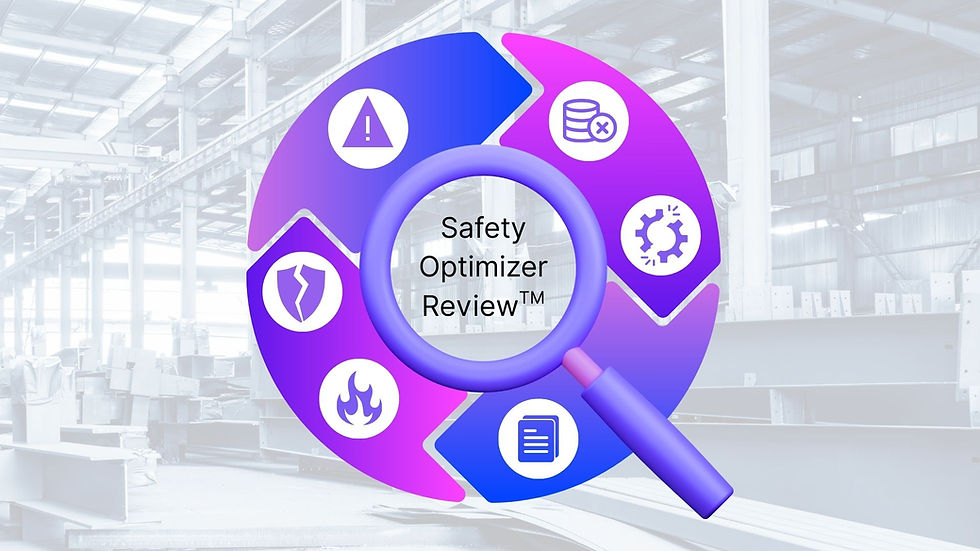The Anatomy of Safety 4.0: What Smart Safety Really Looks Like
- Lucas Domingues
- Jun 23
- 4 min read
The future of workplace safety has arrived, but most organisations and safety pros are not ready for it.
While industries continue to face mounting pressure to reduce incidents, meet compliance expectations, and protect workers, many still rely on outdated systems and reactive strategies. Paper reports, manual audits, and siloed tools have become safety liabilities.
Safety 4.0 represents a shift: From fragmented efforts to intelligent, integrated systems. But what does a Safety 4.0 system actually look like? And how can organisations start building one? This article explores the anatomy of modern safety systems, the enabling technologies behind them, and the leadership mindset required to make safety proactive, data-driven, and strategic.

What Is Safety 4.0?
Safety 4.0 is the application of Industry 4.0 technologies such as artificial intelligence (AI), the Internet of Things (IoT), cloud platforms, and automation to the field of environment, health, and safety (EHS).
In practice, this means:
Replacing manual reporting with real-time data capture
Using analytics to identify risk patterns
Automating compliance workflows
Empowering safety teams with predictive insight
Instead of responding to incidents after the fact, Safety 4.0 enables organisations to detect early signals, understand underlying trends, and act before harm occurs. This marks a shift from lagging indicators to leading indicators, from hindsight to foresight.
The Four Layers of a Safety 4.0 System
A mature Safety 4.0 ecosystem functions as an intelligent, responsive system made up of four core components. Each plays a unique role in transforming how organisations monitor, manage, and mitigate risk. The goal is to establish a continuous data flow from frontline activities and infrastructure, enabling early hazard detection and contextual awareness.
1. The Sensing Layer: Real-Time Data Collection
This layer captures signals from the physical work environment using:
IoT sensors for temperature, air quality, noise, or motion
Wearable smart PPE to monitor fatigue, location, or stress
Mobile devices and safety apps for incident reports and observations
Drones and vision systems for remote inspections and asset monitoring
2. The Processing Layer: Insight Generation
Raw data is only useful when converted into insight. AI models and analytics tools within this layer. This layer acts as the system’s brain, helping organisations move from information to understanding:
Correlate data across sources
Detect anomalies and near-miss patterns
Generate predictive risk scores
Learn from historical trends to anticipate future issues
3. The Interface Layer: Human Interaction
Safety decisions still require human judgment. The interface layer ensures that insights reach people in a clear, actionable format. Well-designed interfaces reduce information overload and ensure that the right people receive the right data at the right time. This includes:
Live dashboards and heatmaps
Mobile alerts for frontline workers
Automated reports for managers and regulators
Voice-enabled safety assistants for briefings and check-ins
4. The Action Layer: Workflow Automation
This is where insight meets execution. By reducing delays and manual follow-up, the action layer supports faster and more consistent safety responses.Automated systems can:
Trigger corrective actions based on thresholds or events
Assign and escalate tasks
Close the loop on audits and inspections
Update compliance records automatically
The Changing Role of the Safety Leader
Safety 4.0 does not replace human expertise. Instead, it enhances it.
With data-driven tools in place, safety professionals can spend less time on repetitive administrative tasks and more time on high-value activities. They become facilitators of culture, leaders of change, and architects of smarter systems.
This requires new skills in digital literacy, cross-functional collaboration, and strategic thinking and a willingness to evolve from inspector to innovator.
Strategic Benefits of Safety 4.0
Organisations that adopt Safety 4.0 approaches report measurable improvements across multiple areas:
Operational
Reduced incident frequency and severity
More effective inspections and follow-up
Shorter response times and fewer manual errors
Compliance
Enhanced audit readiness and traceability
Faster documentation of training, controls, and incidents
Alignment with ISO standards such as 45001, 27001, and 42001
Cultural
Higher frontline engagement
Greater trust in safety processes
Improved transparency and communication
Financial
Reduced costs from downtime, injuries, and penalties
Improved productivity through automation
Competitive advantage in tenders and partnerships
From Tools to Systems
One of the most common challenges in safety transformation is tool fragmentation. Many organisations invest in multiple platforms , one for audits, one for training, another for reporting — but none of them talk to each other.
Safety 4.0 is not just about adopting more tools. It’s about integrating them into a single, intelligent system that supports real-time insight, collaboration, and agility.
Getting Started
Transitioning to a Safety 4.0 model doesn’t have to be overwhelming. Start with a simple framework:
Assess your current digital maturity and pain points
Identify high-impact areas for automation or data integration
Pilot new solutions in a focused environment
Align safety, IT, and operational leadership around a transformation roadmap
At Shield360, we guide safety leaders through this process using our Safety Innovation Discovery — a structured diagnostic that identifies immediate opportunities for improvement and long-term pathways to Safety 4.0 capability. You can book a free strategy session here:
Conclusion
The world of work is changing. Risks are more dynamic, and expectations around safety and compliance are higher than ever. Safety 4.0 is not a buzzword. It’s a strategic imperative.
Organisations that embrace intelligent, connected safety systems will not only prevent more incidents — they will become more resilient, more efficient, and more trusted by workers, partners, and regulators alike.
Now is the time to make the shift.
Are you currently exploring Safety 4.0 initiatives for your company?
Yes
Not yet
I need help to get started




Comments